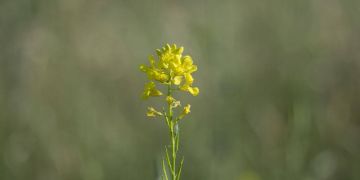There are many varieties of mustard; they all have very pungent flavors. Some medicinal mustard compounds date back to at least 400 B.C. The name is derived from the Latin, mustum. Other names for mustard are white mustard, yellow mustard, pepper grass, and hedge mustard.
Mustard is the second most popular spice traded around the world. Pepper is the first.
Use of Mustard Seed
As early as 1699, it was claimed that mustard seed could strengthen the memory, expel heaviness, and revive the spirits. Mustard seed was recommended in 1653 for toothaches, joint pain, skin problems, and stomach aches. Mustard plasters are used to clear up chest congestion and relieve arthritic and rheumatoid pain and soreness.
Stimulates digestive system
Mustard seed is used to strengthen the digestive system as it can stimulate the flow of gastric juices so to aid with digestion and metabolizing fat in the body as well as encouraging a healthy appetite. While it calms the stomach it can also act as a laxative. It has also been used to cure stubborn hiccups. Mustard seed has been used as an emetic (a substance that promotes vomiting) for centuries. It will allow for the elimination of everything in the stomach without depleting the system.
Warming herb
Since mustard seed is a stimulant it will warm the circulatory system. This can result in dilated blood vessels, plus a warmed system can help burn and metabolize fat in the body. As a warming herb, mustard seed will encourage perspiration that can lower fevers and cleanse the body of toxins. This will help the body fight colds and flu.
Relieve muscle pain
Mustard seed extract can be rubbed on the back to relieve back pain and spasms. It will warm the body when rubbed on sore joints and muscles thereby providing relief and loosening tightness.
Consumption
White mustard seed can be taken as a tea or sprinkled in bath water to help with chest congestion and colds.
The recommended dosage is to take two capsules one time a day with a glass of water early in the day.
Mustard Plasters
Mustard plasters and poultices are tried and true remedies to relieve arthritic joints, sciatica, neck pain, backache, neuralgia, and muscle pain. The mustard plasters work by dilating the blood vessels to promote the increase of blood flow to the surface of the skin. This warms the affected area and removes any toxins from that area. Poultices and plasters are also used to relieve respiratory infections and helps treat chest congestion, pneumonia, bronchitis, and croup.
How to use
A mustard plaster is made by using 4 tablespoons of flour, 2 tablespoons dry mustard, and lukewarm water. A paste is made that is easily spread but not too watery.
The most effective way to apply any poultice is to use 100 percent flannel and spread the mixture over on half of the flannel and fold the other half to make a package. Apply the poultice to the chest, cover with a heavy blanket to encourage sweating. Do not apply the mustard plaster directly to the skin as it will burn.
The mustard plaster should be left on for up to 20 minutes. If the skin turns red remove the plaster immediately.
Once it has been removed from the chest, wipe the area thoroughly. Then use the same method to apply to the back. A warm shower will be good after the poultice is removed.
Though modern medicine has mostly replaced the use of mustard plasters, those who use them know that it is a great way to draw respiratory toxins from the body in a natural way. The plasters also work on sore muscles, gout, sore backs, and poor circulation.





